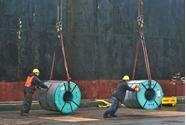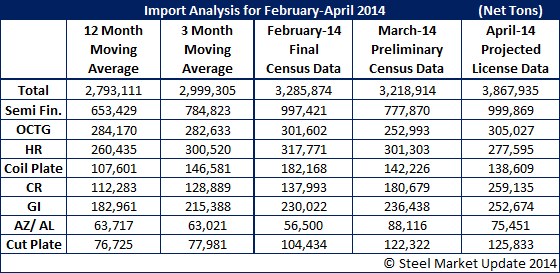Steel Products Prices North America

Preliminary Census Data Has March Imports at 3.2 Million Tons
Written by Brett Linton
April 24, 2014
The U.S. Department of Commerce released preliminary steel import census data for March and reported total steel imports at 3,218,914 net tons (NT). Compared to February, March imports are down by 2.0 percent or 66,960 NT. Compared to the same month one year ago, total March 2014 imports are up 25.2 percent or 648,510 NT. As we have mentioned on numerous occasions, license data and projections from license data can be misleading and one should use that data as a way of identifying a trend but not a final number. The license data has been suggesting March imports would be 3.5 million tons instead of the just reported 3,218,914 net tons.
Slab imports fell 22.0 percent or 219,550 NT from February to March, but were up 56.6 percent over figures from the same month one year ago. As an aside, SMU is hearing that the biggest importers of slab are AM/NS Calvert, California Steel, NLMK USA and AK Steel.
Imports of oil country tubular goods (OCTG) in March were down 16.1 percent or 48,609 NT over February. Compared to import levels one year ago, March imports were up by 0.2 percent
Hot Rolled imports were down 5.2 percent over the previous month, but were up 40.4 percent compared to March 2013 figures.
March imports of cold rolled products rose 30.9 percent over February. Compared to one year ago, this month is an increase of 88.5 percent. The largest increase coming from Canada which increased by 20,000 net tons from the prior months and 25,000 tons compared to this time last year. China, compared to March 2013 was up 12,500 net tons while only being up 550 tons from the month of February. The top three exporters for the month of March were Canada, China and South Korea (up 55 percent from the month before).
Galvanized imports remained steady from February to March and increased by 2.8 percent. Looking back to the same month last year, March imports rose by 25.0 percent.
Imports of other metallic coated products (primarily Galvalume) were up 56.0 percent in March over the previous month. They were also up 41.2 percent over figures from March 2013. The biggest change coming from Taiwan which saw its exports rise by 15,800 tons compared to the previous month and up 17,160 tons over last March figures. The top 3 exporting countries are Taiwan, South Korea and China.
March imports for plates in coils fell 21.9 percent over February, but were up 96.6 percent compared to one year ago. The biggest change in plate in coils from last year were South Korea and Russia. South Korea is up by 23,300 tons and Russia by 14,800 tons.
Imports of plates cut lengths rose by 17.1 percent in March over the previous month. Looking back to this time last year, March 2014 imports are up 83.0 percent. Top three exporters are South Korea, Brazil and Turkey. South Korea had the largest increase over last year with 15,400 tons, Brazil was up 13,300 tons and Turkey also up 13,300 tons.
Below is a model of our import projections throughout the month of March and how they compare to the preliminary census data just released.

Brett Linton
Read more from Brett LintonLatest in Steel Products Prices North America

Nucor slows HRC price climb with $5/ton increase
After eight weeks of double-digit price increases on hot-rolled (HR) coil, Nucor slowed the price rise this week with an increase of $5 per short ton.

Domestic CRC prices surge ahead of imports
The price spread between stateside-produced CR and imports reached its widest margin in over a year.

Evraz raises plate prices $160/ton
Evraz North America (NA) has followed Nucor and SSAB with a plate price increase of its own: up $160 per short ton (st). The increase was effective immediately for all new orders of carbon, high-strength low-alloy, and normalized and quenched-and-tempered plate products, as well as for hot-rolled coil, the steelmaker said in a letter to […]

Nucor lifts HR coil to $820/ton
Nucor has increased its consumer spot price (CSP) for hot-rolled (HR) coil for a fourth consecutive week.

Nucor pushes HR spot price to $790/ton
Nucor increased its consumer spot price (CSP) for hot-rolled (HR) coil to $790 per short ton (st) on Monday, Feb. 10 – a $15/st bump vs. last week. The Charlotte, N.C.-based company has raised its weekly CSP by $40/st over the past three weeks after maintaining tags at $750/st since Nov. 12, according to SMU’s […]


